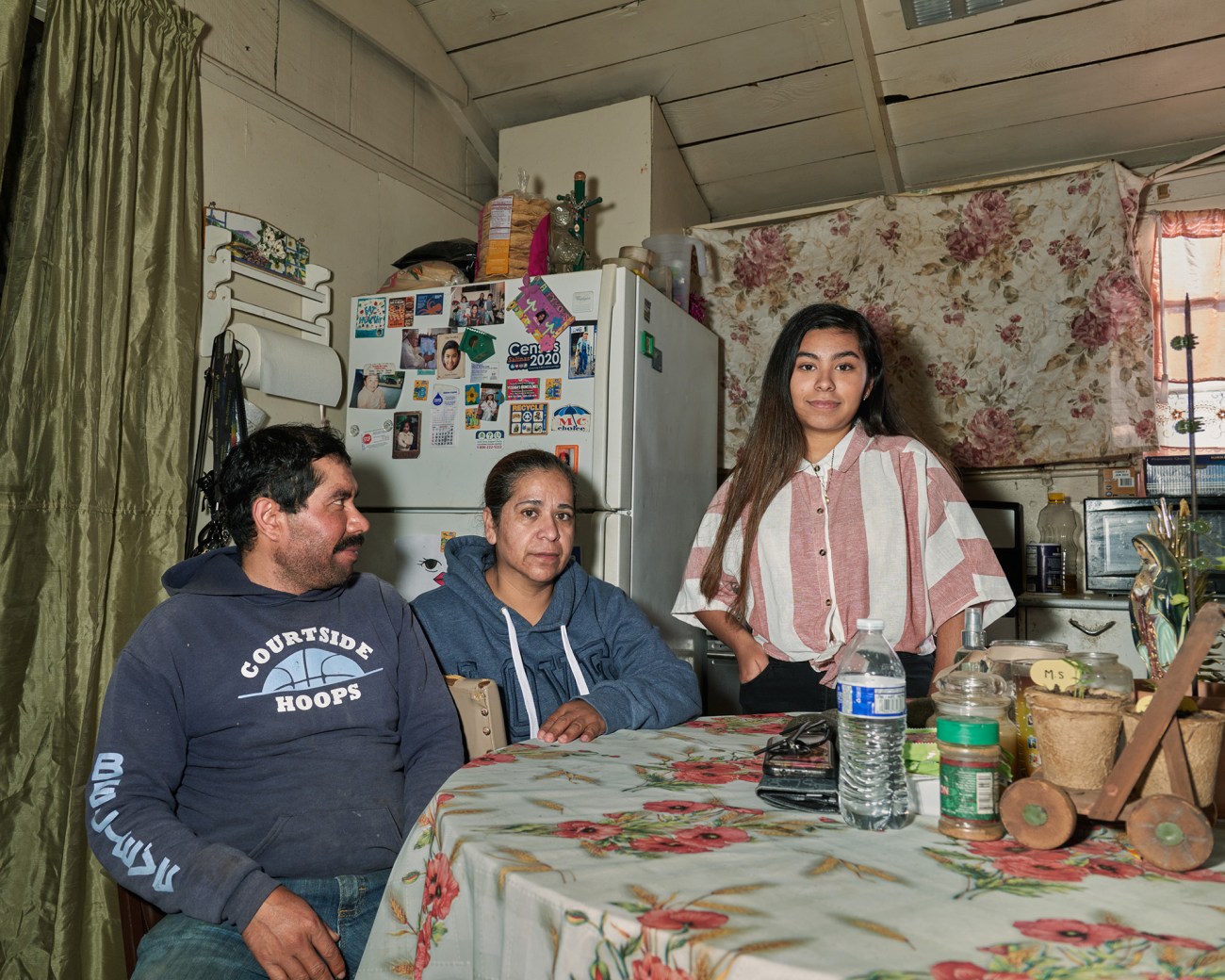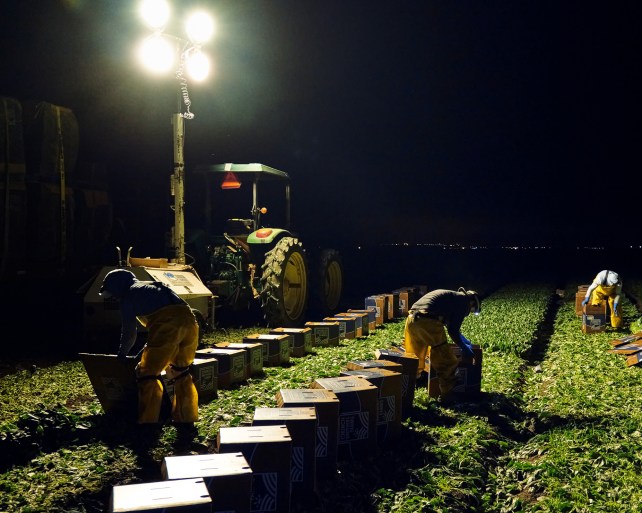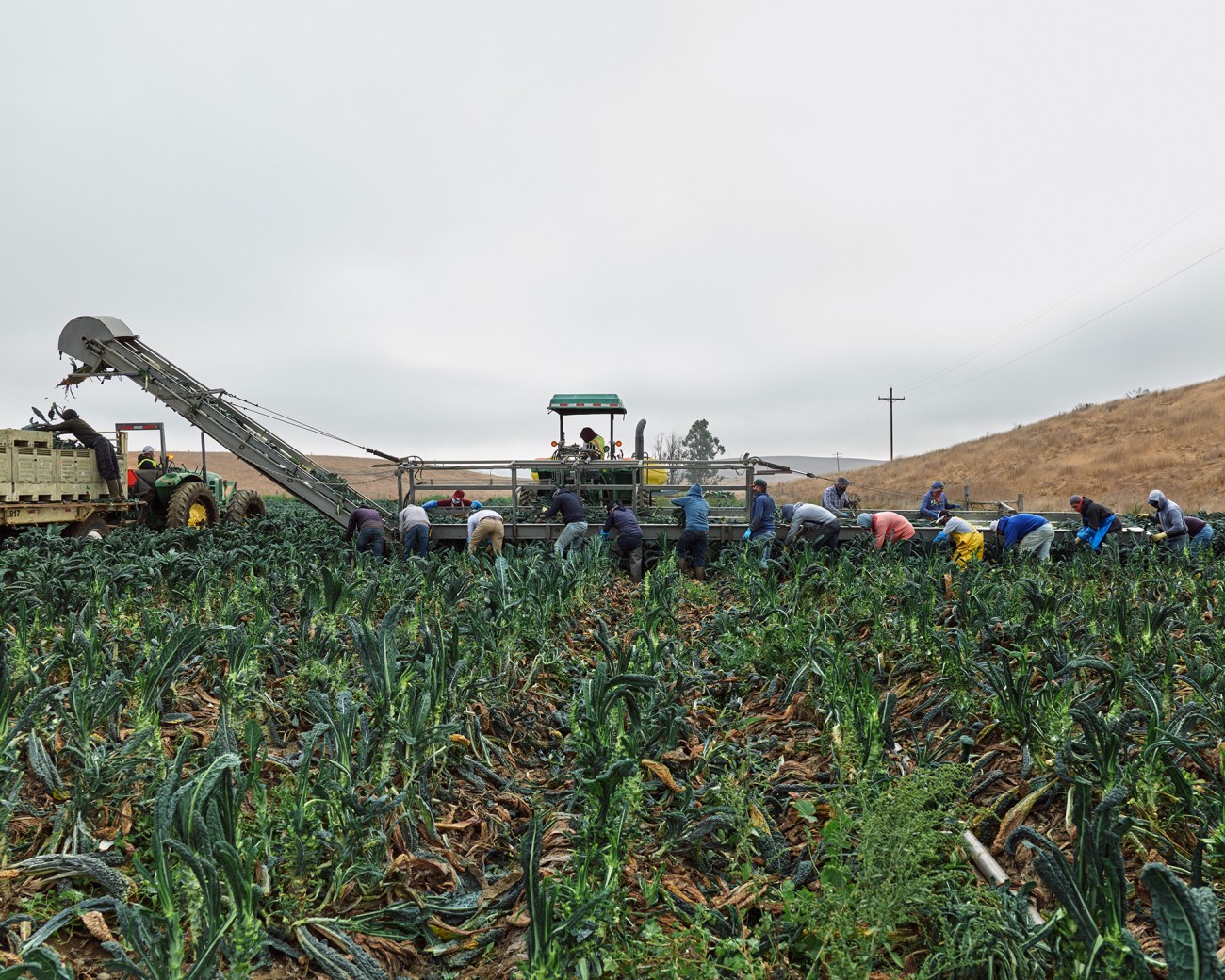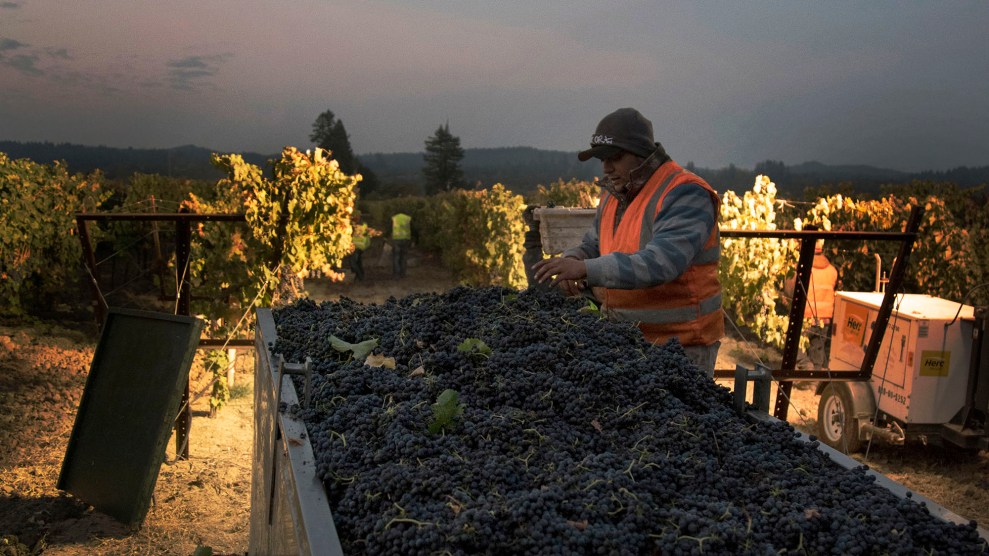Thousands of lightning bolts illuminated the California skies on Sunday, August 16. Early that morning, one of them touched down in a patch of chaparral in Monterey County’s Sierra de Salinas, a low mountain range abutting the valley that produces more than half of the lettuce, almost half of the broccoli, and roughly a third of the cauliflower grown in the United States every year. Sixteen-year-old Magaly Santos, whose father works on an irrigation crew and whose mother drives a tractor for a cauliflower company, first saw the flames as pinpricks of orange light in the distance. Over the next two days, dry winds propelled the blaze in the direction of her home just outside of the farming town of Gonzales. “It was the most devastating thing ever to see our mountains in flames,” Santos says. “My sister and I were like, ‘Oh my god, what about all the animals? And the houses—the people that had to evacuate?’ It was just totally scary.”
On Tuesday, Magaly’s mother called her from the fields, sounding frantic, and told her to start packing up the family’s belongings—the piggy bank containing the money meant for her 12-year-old sister Ximena’s future Quinceañera, savings dispersed around the house, laptops, a change of clothes. The family ultimately never needed to evacuate, and the wildfire, though it charred nearly 50,000 acres and destroyed 30 structures over the course of 19 days, spared human lives. But the situation unnerved Magaly. If they’d had to evacuate: “We had no idea where we were going to go.” And if their home burned down, finding another one in the area would be near impossible.
Around 90,000 workers power the agricultural engine of the fertile Salinas Valley. But there isn’t enough affordable housing to go around. “You have essentially Bay Area prices combined with a workforce making $15 an hour,” explains Matt Huerta, a Salinas-based affordable housing consultant and community activist. Median rent for a two-bedroom apartment in the city of Salinas, around $1,700 a month, is 50 percent higher than the national average. Farmworkers get by on a median income of roughly $25,000 a year.
In 2018, a group of researchers led by the nonprofit the California Institute for Rural Studies determined that the Salinas Valley and nearby Pajaro Valley would need to build an additional 46,000 dwellings to give every family a roof over its head—a mass of housing the size of another city. Only a few hundred affordable units have been built since then. While developers and local municipalities dither, farmworker families increasingly crowd into apartments and homes.

Magaly Santos with her father, Paulo Santos.
Magaly has lived for the past 13 years in a former labor camp built to house braceros, single men brought over from Mexico to harvest US crops starting in the 1940s. The Santos family has its own two-bedroom unit, one in a row of three lined up under one long roof. But some of Magaly’s neighbors live two families to a unit, sharing one bathroom.
This year, across the surrounding valley, housing and financial insecurities are magnifying the twin catastrophes of an unprecedented wildfire season and a pandemic. Crowded living situations likely quickened the spread of the coronavirus. And with limited paid sick leave, and dwindling work hours, many people feel they have no choice but to work through the health risks of contagion and wildfire smoke. According to Magaly, who spent the summer talking to workers in and around Gonzales in her capacity as a youth commissioner, during the pandemic, “farmworkers became even more disposable than they already were.”
When the coronavirus hit and the economy faltered, restaurants and schools nationwide stopped ordering fresh produce, and growers slowed their pace. The virus indirectly robbed many people of work hours and much-needed paychecks—nearly half of the agricultural workers polled in a recent California survey have made less income since the onset of COVID-19. Monterey County saw a 40 percent drop in employment.
Magaly’s mom lost some hours, and the Santoses tightened their budget, cutting off the kids’ cell phone plans. Magaly is now paying for her own plan with money earned from her job on the youth commission. “I didn’t realize how much my family depends on the week-to-week check,” she says. “I can’t imagine what other families are going through.” Even before the pandemic, a third of Monterey County’s residents struggled to put meals on the table. Food bank lines now wrap around the block.

Families wait in line for food, masks, and school supplies distributed by United Farm Workers in King City.

Part of the challenge, says the California Institute for Rural Studies’ executive director Ildi Carlisle-Cummins, is that many different low-wage jobs dried up at the same time—for instance, people lost restaurant service jobs, or side gigs working at flea markets or tourist attractions. This meant there were more people vying for agricultural work, she says, “so then you had crews grow to 100 people working four hours a day instead of 40 people working eight.”
A slimmer paycheck whittles away options for families on the edge. “A lot of folks are getting laid off, and they have to find shelter,” says Juan Martínez, a Gonzales native and longtime farmworker advocate. Martínez rents homes on his property, and one of them currently houses six adults and four kids in four bedrooms.
Ten days before the start of the lockdown in March, Cyntia, a mother of four children, ages 2-11, was evicted from the subsidized apartment she rents in the town of Camphora, seven miles down the road from Gonzales. (She asked me not to use her real name given the precariousness of her situation and her lack of papers.) Though she says she’d always been a good tenant and paid rent on time, an audit of the building determined she didn’t qualify for the subsidy (she says a building manager filled out her form incorrectly), and her landlord sent her a nasty email telling her to get lost within thirty days. With nowhere to go, Cyntia says she became so stressed she landed in the hospital.
Then, in March, California Governor Gavin Newsom signed an executive order placing a moratorium on evictions through the end of May. Cyntia had already put all her belongings in storage, but she decided to stay in the apartment. She and the kids, plus her 15-year-old sister who lives with her, slept on mattresses on the floor. The relief of staying put soon wore off; in June, she hurt her knee and needed surgery, so she had to leave the farm cleanup crew she worked for and go on disability.
On August 31, Newsom signed another order extending the moratorium to February 1, 2021. Cyntia may be able to stay in Camphora for five more months, but her prospects after that are daunting. The father of her kids, who has a job with an irrigation company, makes $300-400 less a week than before the pandemic. He and Cyntia have submitted applications for new apartments, but they’ve been turned away because of their credit scores. And applying for housing isn’t cheap: Cyntia says she’s paid $45 just to have her application evaluated. “I would leave here if I didn’t have kids,” she told me in Spanish on the phone. “What am I supposed to do, go live with my kids under a bridge?”
The Salinas Valley has suffered from overcrowding for years, if not decades, Huerta, the affordable housing advocate, says. But it’s been much more intense in the past five years, as the settled agricultural workforce ages out and growers sponsor H-2A workers—mostly young, single men from Mexico, on a temporary visa—to replace them. In 2013, Huerta remembers, there were only a few hundred H-2A workers in the Valley, but by 2018 that number swelled to 10,000, out of a total of 90,000 agricultural workers. Companies working with the H-2A program must sponsor housing for these men, and they’ve done so by cramming workers into apartment complexes, houses, and even hotels. A 2019 survey from the nonprofit Centro de los Derechos del Migrante found that nearly half of workers in this visa program report living in overcrowded or unsanitary conditions. Ana Vargas, a community health advisor in King City, says she’s been outside some of the H-2A residences in the town and had workers tell her they sleep 8 people to a room.
As Salinas growers increasingly turn to this visa, they’ve “converted entire neighborhoods into employee-sponsored housing,” Huerta says—making homes even more scarce for low-income families. The homeless population has exploded, he says: “We see more families living out of their cars.” Some people make do in garages, tents, and tool sheds.

Magaly Santos with with her parents, Paulo Santos and Maria Salazar, inside their home in Gonzales.
With living space so tight, quarantining becomes near impossible. Families that doubled or tripled-up inside homes and apartments have been some of the hardest hit by the coronavirus. Farmworkers were three times as likely to test positive for COVID-19 as workers in any other industry in Monterey County, research by the California Institute for Rural Studies shows. Rick Mines, an agricultural economist who designed and for many years implemented the Department of Labor’s National Agricultural Workers Survey, helped the Institute with its 2018 housing report and tracked zip codes associated with the most crowded homes. This summer, he cross-tabulated those areas with county health data and his preliminary findings suggest that the areas with more homes with more than one family in them experienced a higher number of coronavirus infections.
Even more disturbingly, COVID-19 disproportionately kills farmworkers. Latinos are more than three times as likely as white people to die from the virus. For those living in rural counties, the risk of dying from COVID-19 may be highest for those who do farm work, who do not speak English, and those living in poverty, according to the preliminary findings from a study by University of California–San Diego’s School of Medicine. Many people in the Salinas Valley fit into all three buckets.
Rough work conditions add an additional layer of risk: Only slightly more than half of the employers of the people surveyed by the California Institute of Rural Studies this summer gave out masks to protect workers from the virus while on the job, or on the bus to and from the fields. “We’ve heard of employers and contractors who were charging for masks,” says Diana Tellefson, the executive director of the United Farm Workers Foundation, a sister organization to the union. When workers fall ill, some of them would rather stay on the job than report their diagnosis for fear of losing income or being fired, explains Maria Orozco, the mayor of Gonzales.

Harvesting lettuce near King City.

When late summer wildfires up and down the West Coast smothered the Salinas Valley in noxious smoke, “the companies did not give the workers a break,” Vargas, the King City community health advisor, says. “No one stopped.” Smoke irritates airways and can inflame existing respiratory conditions, and preliminary research shows that it is associated with a higher death rate from COVID-19. Despite this heightened risk, eighty-four percent of people polled by the United Farmworkers union in late August said their employer had not supplied them with the N95 masks required by the state to protect people from the unhealthy air.
The Monterey County Agricultural Commissioner acquired 330,000 masks to distribute to labor contractors and growers, but several of the farmworker advocates I talked to questioned whether these masks were filtering down to the workers themselves. The UFW began handing out N95s along with food and school supplies at their weekly distributions. “Farmworkers are working within various disasters, one on top of another,” Tellefson says. “We know they are going to do what it takes, because they always have. But it’s our responsibility to take care of them.”
If more families in Gonzales had access to their own spaces, they might stand a better chance at avoiding the plague. The city set up a housing support fund, which provides small grants to low-income families to help cover a month or two of their rent. But recent efforts to build new housing have sputtered. Last year, the city council was considering a proposal for a 41-unit affordable apartment complex near the high school, but a large group of longtime Gonzales residents packed council meetings to protest the project’s location. “There was a lot of opposition from people who felt strongly about the traffic,” Orozco says.
The neighborhood around the site was “not the place for more housing, more people, and more cars,” one resident complained during a meeting, before the city council unanimously voted the proposal down. More than a year and a half later, an alternative location for the project has yet to be solidified.

Farming in King City.
As harvest ramped up in September, a light layer of ash from ongoing fires dusted the Salinas Valley’s Romaine lettuce heads and strawberries. The produce would need cleaning before heading to market, making extra work and an added rush for field crews. Many of Magaly’s peers have taken jobs alongside their parents, rising early before Google classroom starts, or skipping school altogether. Magaly tried to convince her mother to let her work in the fields. She refused; “she’s like ‘No, no, no, it’s a hard job.’”
Besides, the teen has college applications to work on and upcoming SATs to study for; she hopes to major in environmental science at UC-Berkeley and become a lawyer one day, to advocate for farmworker rights, and educate the immigrant community on their susceptibility to things like pesticide drift and contaminated water.
But part of her wishes she could do more now. Corda Camp, where she lives, has mostly been spared from coronavirus infections so far. But the camp’s houses are quite small, with living rooms often serving as bedrooms. Isolating someone would be difficult, “which is a little scary,” Magaly says. “If someone were to get sick, where would the rest of their family stay? Or where would the person who’s sick go?”













